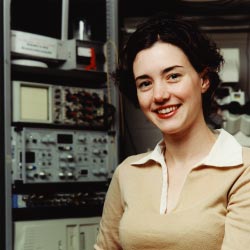|
Enlightened by science
A love of science and a desire to help others has
landed junior Denine Ledyard on a team of researchers studying human
mast cells and their role in treating asthma and other allergies.

Graduate students often do most of the work in
research laboratories. But in one tiny, darkened biology lab, junior
Denine Ledyard spends her days hunched over a petri dish, studying
human mast cells.
Mast cells contain granules that store a variety
of mediators. Every time something happens that needs attention
from the body's immune system, mast cells rush to the rescue. Think
of them as cell-sized emergency technicians. First they evaluate
the environment, checking the temperature and examining the problem,
then they administer first-aid—secreting the appropriate mediator.
If the problem is a blood clot, say, mast cells
might secrete heparin or chondroitin sulfate, powerful anticoagulants
to keep the blood flowing.
But sometimes the rescuers overmedicate. If the
problem is inhaled pollen, mast cells often flood the body with
histamines, causing the runny nose and itchy eyes so familiar to
allergy sufferers.
Scientists know that mast cell surfaces are covered
with receptors, tiny gates that open and close in response to signals
from the cell's environment. What researchers don't fully understand
is what signals cause the gates to open, how they open and what
mediators are secreted in response to various signals.
Ledyard and other researchers working with biology
Assistant Professor Malgosia Wilk-Blaszczak are characterizing one
specific receptor to understand everything about how, when and why
it works.
Ledyard began her UTA studies as part of the Summer
Bridge Research Program, a partnership with Tarrant County College.
A scholarship, awarded through the Louis Stokes Alliance for Minority
Participation, has assisted her. Although many undergraduates undertake
research projects, Ledyard may be unique in her persistence.
"Very soon many undergraduates realize that
experimental work requires long-term commitment, hard work and dedication,"
Dr. Wilk said. "What makes Denine so special is that despite
all the difficulties, she stuck with her desire to do science—she's
stayed in the lab for almost two years now."
Under the direction of Melanie Aschenberg, a graduate
researcher in Dr. Wilk's lab, Ledyard conducts whole-cell patch
clamping experiments. She lowers an ultra-thin, sharp-pointed glass
pipette onto a mast cell and hopes that a good seal will form. An
electronic probe is threaded down the center of the pipette to measure
electrical currents running through the cell membrane.
To complete the experiment, the seal between pipette
and cell must be maintained for 20 minutes, a difficult and frustrating
assignment.
"I learned all my swear words in the lab,"
Ledyard said with a laugh. Some days she works with dozens of pipettes
and cells but can take the full set of measurements only once or
twice.
Still, the painstaking work must be performed
for researchers to know what's happening within the mast cells and
how to control the secretions. An understanding of mast cells will
lead to more effective treatments for asthma and other severe allergies.
Further research will help explain the cells' role in infection
protection and inflammatory diseases.
Ledyard's research career has only begun. "I've
always been interested in science," she said. "I thought
about medical school, but doctors can only use what information
is already known. They can only help a few people. Researchers can
help so many more."
|

